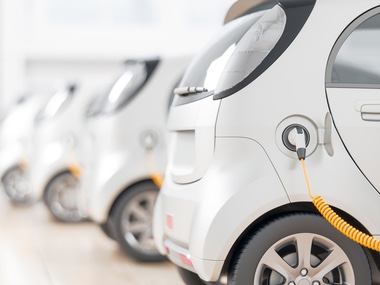
IRS Clean Vehicle Tax Credit FAQs
 The Inflation Reduction Act of 2022 has altered the requirements for the clean vehicle tax credit, particularly for electric vehicles, including fuel cell vehicles. The credit is available for eligible commercial clean vehicles in addition to vehicles that were previously owned.
The Inflation Reduction Act of 2022 has altered the requirements for the clean vehicle tax credit, particularly for electric vehicles, including fuel cell vehicles. The credit is available for eligible commercial clean vehicles in addition to vehicles that were previously owned.
So, what is the clean vehicle tax credit?
For starters, the tax credit can reach upward of $7,500. The credit starts with a base value of $2,500 and increases by a total of $417 per kilowatt hour beyond five kilowatt hours, with up to $5,000 in addition to the base amount of $2,500. On average, the minimum clean vehicle tax credit is valued at $3,751 and applies to vehicles with a battery capacity of seven kilowatt hours at a minimum.
The IRS has put forth a Fact Sheet, FS-2022-42, in an effort to help taxpayers understand the process of applying for the clean vehicle tax credit. According to the IRS, taxpayers who do their best to comprehend the eligibility requirements of the tax credit prior to claiming it will not be penalized should they end up accidentally underpaying their taxes.
According to the IRS’ Fact Sheet, a clean vehicle that is eligible for the tax credit meets specific emissions thresholds, and the vehicle must have been placed into service on Jan. 1 at the earliest. Before the vehicle can qualify for the clean vehicle tax credit, the vehicle cannot be purchased with the intention of being resold.
What are the other qualifications?
Additionally, the manufacturer of the vehicle must be one of the manufacturers named by the IRS and the vehicle must fall within the category of being a motor vehicle as defined by Clean Air Act Title II. The vehicle cannot be operated with more than four wheels and cannot weigh more than 14,000 pounds. Furthermore, eligible vehicles are required to have battery capacities of seven kilowatt hours at a minimum. Last but not least, the vehicle must have documentation that proves its final assembly was completed in North America.
Regarding FCVs, a vehicle of this nature can be considered a clean vehicle if the original use of the vehicle began with you as the owner. Additionally, the FCV must have a final assembly location within North America.
Before you can claim the clean vehicle tax credit, the seller of your vehicle has to provide the IRS with information regarding you as well as your vehicle. There is a list of qualified vehicles called the Clean Vehicle Qualified Manufacturer Requirements, which you can refer to if you are unsure about whether your vehicle is eligible for the new clean vehicle tax credit.
The list is a great resource and is updated on a regular basis to reflect changes as they arise regarding vehicle eligibility. When applying for the tax credit, you will need to verify the manufacturer’s suggested retail price, and final assembly in North America is typically a requirement across the board.
You may be wondering how you can find out whether your vehicle’s final assembly took place in North America and what the MSRP was. In most cases, these details should be discoverable on your vehicle’s information label, which is typically attached to vehicles prior to being purchased from dealers. You can usually search your vehicle’s identification number online by visiting the Department of Energy’s Alternative Fuels website.
Alternatively, you can visit the National Highway Traffic Safety Administration’s VIN Decoder website to discover your vehicle’s final assembly location information. Be prepared to provide your VIN when accessing the NHTSA’s VIN Decoder website. You will also be asked to include your VIN when applying for the clean vehicle tax credit.
Details on the credit
Now, is the clean vehicle tax credit refundable? Can it be carried forward? The answer to these questions is no.
Your clean vehicle tax credit eligibility also may be affected by your annual income level. People who file their taxes as heads of households cannot earn more than $225,000 if they are to be eligible for the tax credit. Married couples who file jointly and people who file as a surviving spouse or widow(er) cannot earn more than $300,000 per year. Everyone else who files taxes faces an annual income threshold of $150,000.
When it comes to clean vehicles, there are limitations that your vehicle cannot surpass in order to be eligible for the clean vehicle tax credit. If you own a van, it cannot be worth more than $80,000. Sport utility vehicles and pickup trucks also have a limit of $80,000. All other vehicles cannot be worth more than $55,000.
If the MSRP is greater than the limitation set forth for your vehicle’s type, your vehicle is not eligible for the clean vehicle tax credit.
For more information, visit the IRS website and check out FS-2022-42.
Recent changes
On October 6, 2023, the IRS sweetened the deal by allowing consumers to access the tax breaks more quickly. According to a Treasury Department statement: “Under the Inflation Reduction Act, consumers can choose to transfer their new clean vehicle credit of up to $7,500 and their previously owned clean vehicle credit of up to $4,000 to a car dealer starting January 1, 2024. This will effectively lower the vehicle’s purchase price by providing consumers with an upfront down payment on their clean vehicle at the point of sale, rather than having to wait to claim their credit on their tax return the next year. Only vehicles purchased under the consumer clean vehicle credits are eligible for this benefit.”
More details on this change are available on the Treasury Department website.



